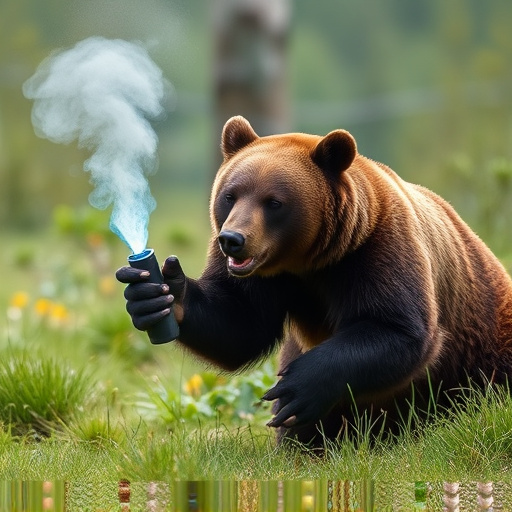Understanding wind direction significantly impacts the effectiveness of bear spray, with calm or tailwinds extending its range up to 30 feet (10 meters), while headwinds reduce it. To maximize safety, users should deploy bear spray facing into the wind, aiming for the bear's face and eyes from a safe distance, and be aware that strong winds can distort the spray's path. Proper knowledge and preparation, including local regulations, are crucial for navigating bear country safely.
“Bear spray, a powerful tool in wilderness safety, boasts an advertised effective range of thirty feet. But what does this distance truly mean? This article delves into the science behind bear spray range, exploring factors like wind direction that can influence its performance. We’ll guide you through optimal usage strategies, offering insights on deployment in varying wind conditions for enhanced Bear Spray safety during your outdoor adventures.”
- Understanding Bear Spray Range: What Does 'Thirty Feet' Mean?
- Factors Affecting Bear Spray's Effective Range
- Optimizing Safety: Using Bear Spray in Different Wind Conditions
- Best Practices for Carrying and Deploying Bear Spray
Understanding Bear Spray Range: What Does 'Thirty Feet' Mean?
Understanding Bear Spray Range: What Does ‘Thirty Feet’ Mean? The effectiveness of bear spray is greatly influenced by several factors, with wind direction being one of the most critical. In ideal conditions, where the wind is calm or blowing away from you, bear spray can reach its maximum effective range of thirty feet (or approximately ten meters). This range ensures that you can effectively deter an approaching bear without putting yourself in close proximity to it.
However, if the wind is blowing towards you, the spray’s range and effectiveness can be significantly reduced. The direction of the wind can cause the spray to blow back at you or disperse prematurely, making it less likely to reach the bear. Therefore, when using bear spray, always take into account the wind conditions to maximize safety during encounters with these powerful animals.
Factors Affecting Bear Spray's Effective Range
The effective range of bear spray is often touted as thirty feet, but several factors can influence this distance. One of the primary considerations is the wind direction. A tailwind can carry the spray further, potentially increasing its reach beyond the stated range. Conversely, a headwind might reduce its effectiveness as the spray is blown back towards the user. Understanding these dynamics is crucial for bear spray safety in diverse environmental conditions.
Additionally, the angle at which the spray is directed also plays a role. Aiming directly at the bear can maximize its impact distance, while a misjudged angle may result in reduced reach. Bear behavior and aggression levels can further complicate matters, as excited or defensive bears might move erratically, making it challenging to predict their proximity and adjust spray applications accordingly.
Optimizing Safety: Using Bear Spray in Different Wind Conditions
When using bear spray, understanding wind conditions is vital for optimal safety and effectiveness. The range of 30 feet is a guide, but factors like wind direction can significantly impact its reach. In calm or light winds, bear spray has a better chance of reaching the intended target within this range. However, in strong headwinds, the spray’s path may be distorted, reducing its effective range.
To ensure safety, users should consider facing into the wind when deploying bear spray. This technique allows for better control and direction, maximizing the spray’s reach while minimizing the risk of backwind exposure. In areas with consistent wind patterns, understanding these conditions can help hikers and outdoor enthusiasts make informed decisions regarding bear spray use, enhancing their overall safety in potential encounters.
Best Practices for Carrying and Deploying Bear Spray
When carrying bear spray, understanding the wind direction is crucial for optimal effectiveness and safety. Always keep the spray nozzle away from your face and body, aiming it in the opposite direction of potential bear approach. A gentle breeze can carry the spray back towards you, so positioning yourself upwind is best. Before a potential encounter, check local regulations regarding carrying and deploying bear spray, as guidelines vary by region.
For safe deployment, maintain a distance of at least thirty feet from the bear while ensuring the spray reaches the animal. When ready, depress the trigger firmly in one continuous motion. Aim for the bear’s face and eyes to maximize its effectiveness. Keep backing away slowly after deployment, allowing the spray to take effect and providing time for the bear to retreat. Remember, bear spray is a tool for deterrence, but it’s crucial to practice and prepare for encounters to ensure your safety in bear country.
Bear spray is an essential tool for enhancing bear spray safety, especially when navigating unpredictable wind direction. Understanding the effective range of thirty feet and the factors influencing it, such as wind conditions, is crucial. By optimizing deployment techniques and following best practices for carrying and using bear spray, folks can ensure they’re prepared for encounters in diverse environments. Remember that awareness and prompt action are key to avoiding dangerous situations with these powerful animals.
